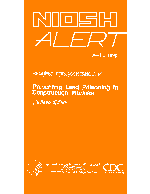Request for Assistance in Preventing Lead Poisoning in Construction Workers
(Revised 1992)
DHHS (NIOSH) Publication Number 91-116a

WARNING! Lead poisoning may occur in workers during abrasive blasting, sanding, cutting, burning, or welding of bridges and other steel structures coated with lead-containing paints.
The National Institute for Occupational Safety and Health (NIOSH) requests assistance in preventing the lead poisoning *of workers engaged in the maintenance, repainting, or demolition of bridges or other steel structures coated with lead-containing paints. NIOSH recently learned of 42 workers who developed lead poisoning while working on bridges. Operations such as abrasive blasting, sanding, burning, cutting, or welding on steel structures coated with lead-containing paints may produce very high concentrations of lead dust and fumes. Furthermore, the recent introduction of containment structures (enclosures designed to reduce environmental contamination by capturing particles of paint and used blasting material) may result in even higher airborne concentrations of lead. Lead dust at the worksite may also result in contamination of workers’ homes and automobiles.
Request for Assistance in Preventing Lead Poisoning in Construction Workers
| Revision Date | Revisions | Citation of Revision |
| April, 1992 (Original) | ||
| 1992 | (Revised: 91-116a) |
